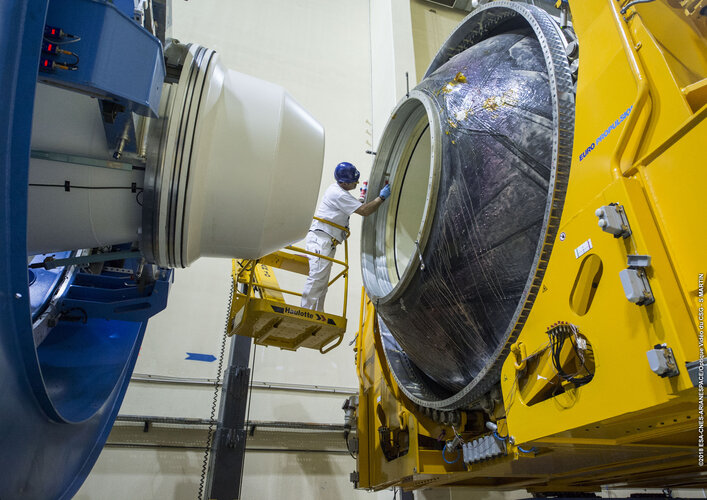
Copernical Team
Full-scale static test concludes qualification testing for Orion spacecraft abort motor
 Northrop Grumman and Lockheed Martin successfully performed the final full-scale ground test of the abort motor for NASA's Orion spacecraft Launch Abort System (LAS) at Northrop Grumman's Promontory test facility. The 17-foot-tall abort motor is one of three motors comprising the LAS that sits atop the Orion spacecraft aboard NASA's Space Launch System (SLS) rocket and is designed to increase as
Northrop Grumman and Lockheed Martin successfully performed the final full-scale ground test of the abort motor for NASA's Orion spacecraft Launch Abort System (LAS) at Northrop Grumman's Promontory test facility. The 17-foot-tall abort motor is one of three motors comprising the LAS that sits atop the Orion spacecraft aboard NASA's Space Launch System (SLS) rocket and is designed to increase as On the road to cultured meat for astronauts and Earthlings
 Cultured meat could be a game changer for the environment, food security, human health and animal welfare. But some challenges prevent it from reaching its full potential. Now ESA is supporting researchers to explore the possibility of growing cultured meat to feed astronauts. Overcoming the challenges of growing meat in space could also help us find solutions to produce it sustainably and effec
Cultured meat could be a game changer for the environment, food security, human health and animal welfare. But some challenges prevent it from reaching its full potential. Now ESA is supporting researchers to explore the possibility of growing cultured meat to feed astronauts. Overcoming the challenges of growing meat in space could also help us find solutions to produce it sustainably and effec Blue Origin launches its fourth crew to final frontier

Jeff Bezos' Blue Origin successfully carried out its fourth crewed spaceflight Thursday, a ten-minute joyride beyond the planet's atmosphere and back again.
The New Shepard suborbital rocket blasted off from the company's Launch Site One base in west Texas at 8:58 am local time (1358 GMT) with six crew members.
The crew included Gary Lai, chief architect of the New Shepard program, plus five paying customers—though the ticket price hasn't been disclosed.
"I felt my skin pulling taut," Lai said, of the rocket ride.
Lai's inclusion came after comedian Pete Davidson, the boyfriend of reality star Kim Kardashian, canceled his participation without disclosing a reason.
Study reveals lunar regolith evolution process on Chang'e-4 landing area

On the road to cultured meat for astronauts (and Earthlings)

Cultured meat could be a game changer for the environment, food security, human health and animal welfare. But some challenges prevent it from reaching its full potential. Now ESA is supporting researchers to explore the possibility of growing cultured meat to feed astronauts. Overcoming the challenges of growing meat in space could also help us find solutions to produce it sustainably and effectively on Earth.
ESA-developed P120C solid rocket motor enters production

ESA’s Ariane 6 and Vega-C will soon join the family of launch vehicles operating from Europe’s Spaceport in French Guiana to guarantee more opportunities for Europe to reach space. The P120C motor, which will power both Ariane 6 and Vega-C, will soon come into operations with the Vega-C inaugural flight.
Harmony in the Wadden

An important milestone in the development of ESA’s tenth Earth Explorer satellite mission, Harmony, has been reached thanks to two aircraft flying in tight formation over the Dutch Wadden Islands collecting key data on sea state and currents. The main purpose of this tricky airborne experiment is to mimic the geometry at which the Harmony satellites will measure various aspects of ocean dynamics to understand how air and the ocean surface interact, which, in turn, will improve weather prediction and climate models.
Environmental data for researchers worldwide
 The Environmental Mapping and Analysis Program (EnMAP) satellite sees the world very differently from the way the people who live there do. The German environmental satellite measures the solar radiation that is reflected by Earth's surface. EnMAP not only captures visible light, but also short-wave infrared.
These data allow precise conclusions to be drawn about conditions and changes on
The Environmental Mapping and Analysis Program (EnMAP) satellite sees the world very differently from the way the people who live there do. The German environmental satellite measures the solar radiation that is reflected by Earth's surface. EnMAP not only captures visible light, but also short-wave infrared.
These data allow precise conclusions to be drawn about conditions and changes on SpacePharma to launch three experiments on AXIOM-1 flight
 SpacePharma is preparing to launch three sets of experiments to orbit on the AXIOM-1 flight.
One is ALEPH FARMS - Meat for Space, which tests a technology for growing meat products from animal cells. The second is CADW which examines whether a specific DNA damage pathway is activated by microgravity. And the third is AMORPHICAL which examines the influence of Amorphous Calcium Carbonate on
SpacePharma is preparing to launch three sets of experiments to orbit on the AXIOM-1 flight.
One is ALEPH FARMS - Meat for Space, which tests a technology for growing meat products from animal cells. The second is CADW which examines whether a specific DNA damage pathway is activated by microgravity. And the third is AMORPHICAL which examines the influence of Amorphous Calcium Carbonate on Japanese space industry startup "Synspective" raises US $100M
 Synspective Inc., a SAR satellite data and solutions provider, announced that the company has raised US $100M (11.9 billion yen) including a Series B funding round. The latest funding was led by Sompo Japan Insurance Inc. (Tokyo, Japan), Nomura SPARX Investment, Inc. (Tokyo, Japan), and Pavilion Capital Pte. Ltd. (Singapore) among others, as well as bank loans, and it is supposed to be ranked wi
Synspective Inc., a SAR satellite data and solutions provider, announced that the company has raised US $100M (11.9 billion yen) including a Series B funding round. The latest funding was led by Sompo Japan Insurance Inc. (Tokyo, Japan), Nomura SPARX Investment, Inc. (Tokyo, Japan), and Pavilion Capital Pte. Ltd. (Singapore) among others, as well as bank loans, and it is supposed to be ranked wi 